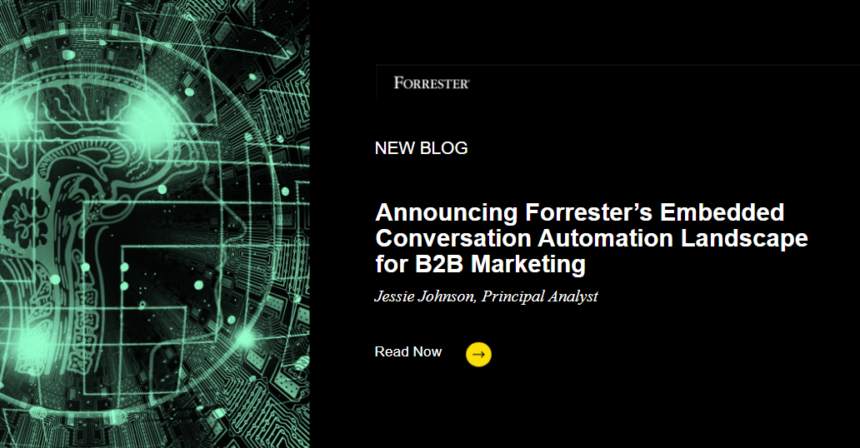Conversational AI, chatbots, and automated marketing are not new to B2B marketing technology stacks. B2B marketing organizations leverage conversation automation solutions to better understand and enable buyers, customers, and internal teams by integrating signal-responsive conversations into existing workflows, tactics, and content experiences that span the full customer lifecycle. Conversation automation is quickly becoming integral to the B2B martech stack: Forrester’s Marketing Survey, 2023, found that 61% of B2B marketing organizations are planning to increase spend on conversation automation.
In a recently published landscape on embedded conversation automation solutions for B2B marketing, we analyzed how this market continues to evolve. This blog covers several of its key conclusions.
Typically packaged as a standalone or embedded solution, conversation automation technologies provide AI-powered chatbots and virtual assistants that work alongside human team members to co-create, facilitate, and learn from conversational interactions and outcomes supporting a range of use cases for lifecycle revenue marketing. Embedded conversation automation solutions offer conversational capabilities as a feature inside core B2B marketing, sales, or content engagement solutions using multiple delivery channels to sustain context-aware dialogue.
Recent innovations in embedded conversation automation solutions fueled by rapid advancements in large language models (LLMs) and generative AI have introduced and refined new capabilities for personalized content experiences, access to audience and marketing performance insights, and content production at scale.
Now, modern business users — buyers and customers, marketers and sellers alike — inspired by their consumer experiences with AI and conversational interfaces are looking to better utilize these technologies for business purposes.
Three Key Benefits Of Embedded Conversation Automation
Where early use cases focused on using chatbots as website greeters and appointment setters, B2B conversation design and automation has matured not just in the technology but in how we interact with our audiences as customer-obsessed organizations. Conversation automation can now support marketing for the full B2B customer lifecycle, improve digital experiences, and provide consistency and context in tactic interactions across delivery mechanisms. Embedded conversation automation solutions with their proprietary LLMs are already tuned to the complex B2B customer lifecycle and supporting revenue marketing processes to ensure optimal interaction experiences for customers and frontline marketers. This enables B2B organizations to:
- Improve responsiveness across multiple delivery mechanisms. B2B marketers must be able to deliver cohesive, dynamic interactions across both self-service scenarios and outbound revenue marketing tactics. Conversational capabilities inside traditional and emerging digital channels provide buyers and customers with new ways to access information through familiar tactics (e.g., browsing websites, accessing content on a mobile app, engaging in social media, etc.), while conversational interfaces embedded inside existing workflows reduce the time it takes to create and deliver personalized experiences.
- Increase contextual relevance of interactions. In equal measures, conversation automation depends on and generates data and insights specific to a business environment and its diverse audiences to sustain responsive, relevant dialogues. Contextual awareness creates an architecture of relevance that helps humans and machines interpret and respond to audience signals with best-fit content and recommended actions. This includes integrating signals from human-to-human dialogues as the conversation evolves to surface role-relevant insights into audience segments and buying groups.
- Drive efficiency and scale in lifecycle revenue marketing processes. Conversation automation enhances and connects digital interactions with buyers and customers while streamlining internal workflows. This helps position B2B organizations for customer-obsessed growth by removing friction from audience interactions and using real-time insights and automation accessible via conversational interfaces to streamline internal processes and revenue development representative handoffs.
Our B2B buyers, customers, and employees are already interacting conversationally with devices and technologies in their personal lives; the expectation to do so in their professional lives will only increase in the future. From enhanced customer experience through relevant, real-time interactions to driving pipeline efficiency through precision outbound, conversation automation embedded in the customer-obsessed growth engine helps organizations meet and exceed the expectations of empowered buyers and customers self-directing their journeys and making decisions as a group.
In addition to reading the recently published Landscape report, Forrester clients can learn more about trends in B2B conversational interactions and embedded conversation automation in an upcoming webinar (if you’re a client) on September 12.








